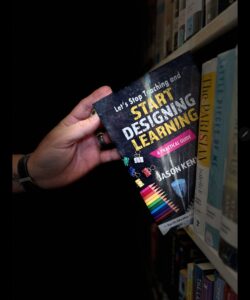If you are a fan of Friends, you are probably mimicking “PIVOT!” right now, and chances are, you will use it at least once in context in the next 24 hours. You’re welcome. If you’ve never seen Friends, or this particular snippet, I urge you now to find it on YouTube. You will not regret it. We’ve all probably been where Ross and the others are. I know I have. There have been times when my obituary came close to including “foldout couch” as a cause of death. Moving is not fun at all. Yet, a lot of students are made into movers every day in our classrooms through what we are labeling as “instruction.”
I’ve been in many classrooms in many different grade levels. Something I find that happens as our students seem to age is that we, through our own instructional choices, begin transforming our students from explorers into movers. Think about it, those primary and early elementary grades are about discovery and creativity. Students are given opportunities to “find stuff out.” However, the older they get, the trend of making them into movers tends to begin.
Not to get into a “vocabulary in isolation” tangent, ELA teachers, we know what best practices are in relation to this. We know that the old standard of weekly lists, copying definitions, regurgitating the information back on a quiz only to have students mentally flush these terms to make room for the next week’s words, isn’t really effective. So, let’s look at some classes that might need some content specific vocabulary to get learning across, like Social Studies and Science.
Not passing judgment, but these classes are the ones that tend to use the Powerpoints, lectures, fill-in-the-blank notes,guided notes, etc to get needed information across to students. I was in a US History class yesterday. The students had a list of 25 “terms” they needed to get the definitions for. I have been in countless other classes where a long list of terms need defining, or blanks from notes being read off a Powerpoint are needing filling in. The question that comes up in my mind is this, “Where is the learning when students are moving a word or a phrase from one place to another?” It reminds me of that scene from Big, where Tom Hanks is playing a boy trapped in a grown-up body. He’s in a corporate meeting of a toy company, playing with a potential toy of a building. His eventual question is this, “Well, what’s fun about that?”
What’s learning about moving information from one pile to another? Why not just give the students the information in the first place? Why take up precious time in class copying, verbatim, words from a screen onto a paper? That’s what we have to ask ourselves when we think about learning and content specific vocabulary. We have to look at what we are asking students to do and ask, “Where is the learning in this?”
My take on it? Give the students the information up front. Then, we design something for them to use this information with that is meaningful to learning. Social Studies, a great deal of the learning in the room encompasses cause and effect relationships, whether they be historical, geographical, political, economical. Science folks, your courses are concerned with making predictions, constructing models or experiments, analyzing results. Preloading any essential vocabulary, in whatever way you deem most fitting, only allows you more time to dig into the deeper learning in your course, the meaningful kind that’s more than moving piles of words from one location to another.
Let’s make learning less about the moving of information and more about making movements with our students. Movements in their understanding, movements in their comprehension, movements in their application, movements in learning. Design for it with intentional decisions that surround and support learning and there’s no limit to how far you will move your students.


